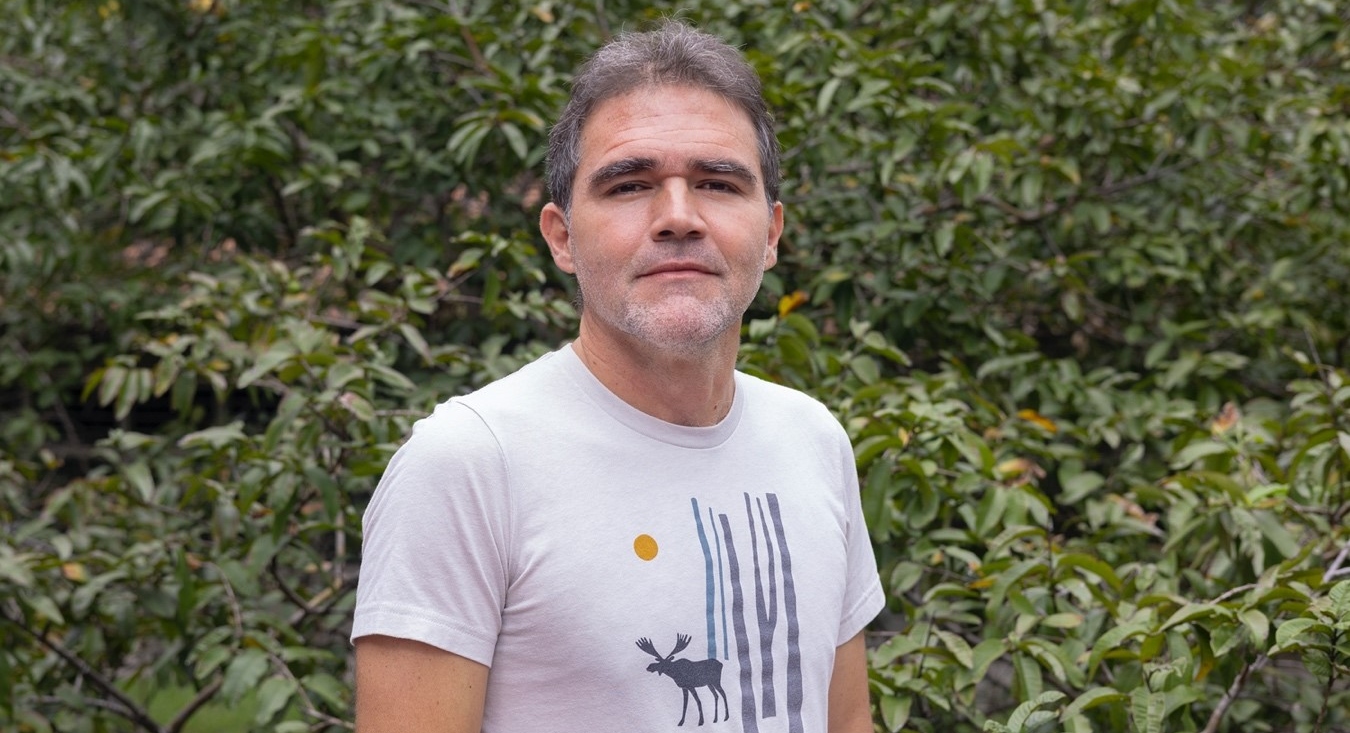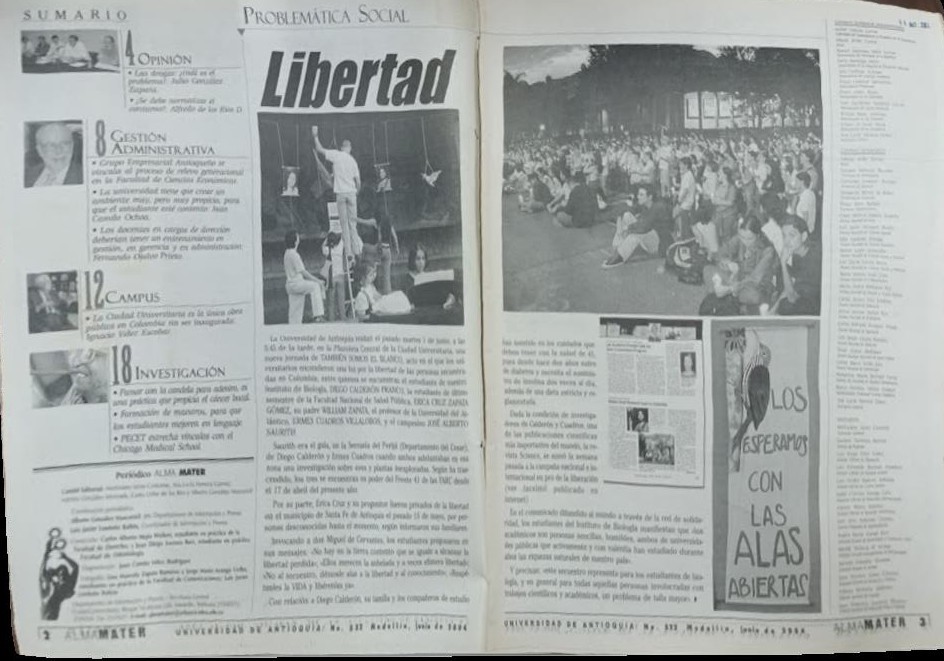-
Idiomas language
- Español check
- Inglés
-
Accesibilidad accessibility
- Aumento de Texto1 format_size Aumento de Texto2 format_size
- Modo Oscuro brightness_2 Modo Claro brightness_5
Generales
 A biologist and a dance student from UdeA joined the production of the series One Hundred Years of Solitude
A biologist and a dance student from UdeA joined the production of the series One Hundred Years of Solitude
- ${title}
A biologist and a dance student from UdeA joined the production of the series One Hundred Years of Solitude
By Ronal Magnum Castañeda Tabares, Journalist at UdeA Communications Office
57 years after One Hundred Years of Solitude introduced the world to Gabriel García Márquez’s extraordinary vision. After securing his place in Latin American literature, the novel has finally made its way to the screen. Two members of the UdeA University community contributed to the production. Susana Morales Cañas, studying for a Bachelor’s Degree in Dance, portrayed the young Úrsula. Diego Calderón Franco, a biologist and avid birdwatcher, recorded the sounds of birds. He also captured the calls of other animals and the ambient noises that helped bring the mythical world of Macondo to life.


Susana Morales Cañas and Diego Calderón Franco, a UdeA biologist. Photo: UdeA Communications Office / Alejandra Uribe F.
Gabriel García Márquez, the renowned writer from Aracataca, refused to allow filmmakers to adapt One Hundred Years of Solitude for the big screen during his lifetime. Although filmmakers attempted to modify several of his works, most fell short of expectations. After years of negotiations, his family finally granted the rights to Netflix in 2019, setting four strict conditions: the production had to use Spanish, take place in Colombia, include Colombians in both the cast and technical team, and secure enough funding to ensure a high-quality result.
With these conditions in place, the first season premiered on December 11, 2024, featuring eight one-hour episodes. The second season will debut in June 2025. Alma Mater highlights the contributions of an Universidad de Antioquia graduate and student in the cast and technical team.
Diego Calderón Franco, a biologist and birdwatcher from Alma Mater, spent three days exploring the Caribbean, recording around 60 bird species to help recreate the sounds of Macondo. Susana Morales Cañas, a fifth-semester student in the Bachelor’s Degree in Dance program, embraced talent, courage, and determination to take on the leading role in the first three episodes of the season.

Diego trained as a biologist but works professionally as a birdwatcher and nature guide. Photo: UdeA Communications Office / Alejandra Uribe F.
Diego Calderón Franco: giving voice to Macondo
To recreate the atmosphere of Macondo in the One Hundred Years of Solitude series, the production team has incorporated nearly 60 bird sounds—each one evoking the rich natural world imagined by Gabriel García Márquez almost seven decades ago. Diego Calderón Franco, a biologist from the Universidad de Antioquia, teamed up with a sound recordist to capture these trills, squawks, and screeches during a journey through the Caribbean. Isolating the songs of these birds proved challenging amid the constant noise of modern life and the shrinking habitats caused by urban growth.
The series’ opening episodes explore the vibrant ecosystems of the Colombian Caribbean—landscapes that Gabriel García Márquez, a coastal-born writer, masterfully captured in his 1967 novel. In Macondo, the fictional world created by Gabriel García Márquez, deserts, lagoons, dry forests, mountains, swamps, and sun-scorched plains converge into a single landscape that reflects Colombia’s extraordinary natural diversity. This convergence of climates places the country among the most biodiverse in the world—and the top in bird species, earning it the title of “holy grail” for birdwatchers. The series brings this natural richness to life, with birdsong playing a central role in its soundscape.
The trills of the Endless (Tapera naevia)—a bird that lifts its crest when it sings—echo throughout the series. This species is common along Colombia’s Caribbean coast and lives in hot, arid, and desert regions. It belongs to the same family as the squirrel cuckoo and shares characteristics with migratory species like the garrapatero.
The partridge (Colinus cristatus), another bird native to Macondo, makes its presence known in the series. With its rounded body and preference for walking rather than flying, it inhabits forest floors, tropical savannas, inter-Andean valleys, and even arid zones. Its song echoes during scenes where José Arcadio, consumed by his inventions and boundless alchemical experiments, begins to unravel mentally. The woodpecker (Melanerpes rubricapillus) also adds to the soundscape with its sharp, rapid, and piercing calls. Its voice punctuates the scenes where Úrsula steps in to restore order, reinforcing her role as the backbone of the Buendía household.
“From the moment he founded the town, José Arcadio Buendía began crafting traps and cages. Before long, he had filled not only his home but every house in the village with turpentines, canaries, bluebirds, and robins. The cacophony of so many birds became so overwhelming that Úrsula, his wife, stuffed her ears with beeswax to avoid losing her grasp on reality…”—Excerpt from One Hundred Years of Solitude (1967), by Gabriel García Márquez.
Diego Calderón Franco, a biologist and graduate of the Universidad de Antioquia, recorded the sounds of more than 90 bird species for the series. (You can listen to many of them his Instagram account.) Coincidence led him to become the production’s unofficial “Birdman.” While working on the sound design for One Hundred Years of Solitude, the audio post-production company La Tina set out to find a Colombian bird sound library that could match the novel’s richly imagined world. Their search led them to WhereNext—the team behind The Birders, a 2019 documentary celebrating Colombia’s birdlife and birdwatching scene, where Diego plays a prominent role. That connection brought him on board as part of the post-production team tasked with bringing Macondo’s soundscape to life.
A post shared by Birds Colombia (@birdscolombia)
He did more than record bird songs. With the help of sound designer Sebastián Martínez, he captured hundreds of ambient sounds—rivers, waterfalls, frogs, mammals, and other elements of the natural world—to enrich the story’s atmosphere. He recorded birds, amphibians, insects, and mammals—all within a week. These recordings brought depth to the series’ soundscape, which took shape during post-production.
They built a detailed sound library spanning dozens of gigabytes, with notes for context and application. “The raw files aren’t enough for the editors,” Diego explained. “They need to know when and where to use each sound. Some birds only sing at night; others belong in thick brush, far from any human presence. We recorded howler monkeys, marmosets, crickets, cicadas—so many cicadas—and even ants. You might not notice them, but they’re there. If you place a microphone close enough, you can hear them.”
Getting to know Colombia
Diego never earned a formal degree in ornithology. Instead, his passion for birds took flight while studying biology at the Universidad de Antioquia. In 2004, he led a biological expedition to the Perijá mountain range, a remote region straddling the border between Cesar and La Guajira. Alongside fellow researchers, he set out to document local wildlife, focusing on two rare bird species found only in that range: the shimmering Metallura iracunda hummingbird and the secretive Perijá thistle-tail (Asthenes perijana), both now endangered.
Since the 1970s, the Perijá mountain range—like many rural areas in Colombia—had been off-limits to researchers due to the armed conflict. The presence of guerrilla groups made scientific exploration nearly impossible. In 2004, as a biology student at the Universidad de Antioquia, Diego Calderón Franco organized a research expedition to the region to study rare species, including a hummingbird (Metallura iracunda) and a chamicero (Asthenes perijana), both endemic and endangered. During a preliminary visit, at just 23 years old, he was kidnapped by the 41st Front of the FARC. Along with a professor from the University of Atlántico and a muleteer from Manaure, he spent 88 days in captivity. The guerrillas grew suspicious of the group because of the GPS devices, cameras, and binoculars they carried.

The newspaper Alma Mater of the Universidad de Antioquia reported on the disappearance of student Diego Calderón Franco and the cultural events held to demand his release. Photo: Archive.
Diego launched COLOMBIA Birding in 2007, offering expert-led expeditions to remote, rarely explored regions teeming with birdlife. In Chocó’s Mecana Hill, beyond Bahía Solano in the Baudó subregion, he spotted a tanager (Chlorospingus inornatus) once thought to exist only in Panama. His routes also include the Serranía de Pirre in Darién, the forests and mountains of Putumayo, and the unique white-sand ecosystems of Mitú in the Guiana Shield.
Since 2018, Diego has joined birdwatching missions with demobilized members of the Farc guerrillas—the very group that held him captive in 2004. In his talk Pajariando con Farc, he reflects on these encounters as part of a broader call for reconciliation and the shared responsibility of rebuilding Colombia.
A winged connection
In his interview with Alma Mater about the Netflix series, the biologist spoke about the birds that surround us—and the quiet superpower they’ve given him: the ability to perceive reality with a heightened awareness of sound, presence, and flight.
“You may not have noticed, but as we talk, I could name at least ten birds around us—azulejos, bichofué, loritos... I could close my eyes and, simply by hearing them, know we’re west of the Andes—not in the Llanos, the Amazon, or Chocó. I know I’m in the inter-Andean valleys of the Caribbean,” said the birdwatcher, sitting at one of the stone tables in the Sports Area of the Universidad de Antioquia, his Alma Mater.
“Birds have always been the perfect excuse. Today, they’re the reason we’re talking about One Hundred Years of Solitude; yesterday, they brought me to a Netflix production. But more than that, they’ve led me back to the former guerrillas who kidnapped me in 2004—now demobilized and working in bird tourism. Birds, somehow, bring the most unlikely stories together.”

Following three years on set, Susana has returned to UdeA to continue her studies. Photo: UdeA Communications Office / Alejandra Uribe F.
Susana Morales Cañas: from dance to the screen
Susana Morales Cañas never saw herself as an actress—much less as the lead in a series inspired by the Buendía family saga. Her interest in the arts began early, leading her to explore photography and languages—though neither quite resonated. Eventually, she returned to something that had moved her: dance. That passion led her to the Bachelor’s program in Dance at the Universidad de Antioquia’s Faculty of Arts. Determined to earn her spot, she threw herself into ballet and contemporary dance training, and after passing the demanding entrance exam, she found where she truly belonged.
At twenty, Susana began her degree in Dance, immersing herself in contemporary, traditional Colombian, and ballet techniques. Over time, she shaped her own artistic identity—one that would later guide her surprising leap into acting.
Coincidence and prominence
Acting was never part of Susana’s plans—until a spontaneous outing with friends led her to an open casting call for Netflix’s adaptation of One Hundred Years of Solitude. The production was searching for fresh, unfamiliar faces across Colombia. By coincidence, she walked into an audition focused on dancers and circus performers, meant to bring to life scenes like the arrival of Melquíades’ gypsy troupe, who visited Macondo each year with their strange inventions and stories from the outside world.
Susana originally went to support a friend at a casting held in a classroom at UdeA’s Faculty of Law and Political Sciences. But once there, she was invited to audition, too. “I thought, ‘Why not?’” That unexpected moment sparked a six-month selection process that ultimately led to her landing the role of young Úrsula Iguarán—one of the main characters in the series’ first three episodes.
The audition process was intense from the start. The first round didn’t involve any lines—just improvisation. “The casting director asked me about my last argument. I told him about a recent breakup. Then he said, ‘Pretend I’m your ex’s best friend, and I’ve come to insult you. You need to strike first.’” Each stage grew more demanding, leading to scene work with the actor playing José Arcadio Buendía. Finally, in February 2023, she received a call confirming that she had landed the role.
Susana faced every part of the process as a newcomer—navigating casting, learning the language of film, memorizing lines, shaping Úrsula’s character, and moving naturally with others on set.
Once selected for the role, she entered a rigorous three-month preparation that involved individual and group rehearsals, script work, costume and makeup tests, and daily Cordovan accent training. “We had constant sessions with the accent coach, who corrected us at every turn.” She also trained with an intimacy coordinator to handle the series’ explicit scenes confidently and respectfully.
Filming spanned from May to December 2023, split into three production blocks. Susana worked for three months under the direction of Argentine filmmaker Alex García López (Misfits, The Witcher, Daredevil). Taking on the role of Úrsula challenged her on multiple levels: “Learning the language of film was hard, but so was relating to her as a real, complex woman. I saw parts of her in my mother, in women around me.”
He shares that the birth and exodus scenes of the Buendía family were mainly demanding, with extreme weather and heavy emotions pushing him to his limits. “I grew tremendously—professionally and personally. I had to open myself to a world I’d never pictured,” says the 23-year-old actress, now in her sixth semester of the Dance BA program at the Universidad de Antioquia.
New Horizons: a future in film and dance
One Hundred Years of Solitude marked a turning point in Susana Morales Cañas’ career, opening unexpected paths in the film industry. In 2024, she completed work on two new films. She plays the lead in La Cordillera, an independent thriller produced in Panama. The film will premiere this year and appear on the festival circuit. Her second project—a Colombian production in which she plays a supporting role—is currently in post-production, with details still under wraps. Now represented by a manager, Susana is exploring new projects while continuing to nurture her passion for dance.
Even with her rising success in film, Susana remains committed to dance. She’s currently rehearsing tango with a UdeA performance group. “I don’t want to lose touch with the university or dance,” she says. “It’s something I truly enjoy, and I believe the program here is outstanding.”
With her career on the rise, Susana Morales Cañas stands out as a promising new voice in Colombian cinema. What started as a leap of curiosity has blossomed into a passion that continues to shape her journey—both on screen and in dance.
 Portal U de A - Redes Sociales - WCV(JSR 286)
Portal U de A - Redes Sociales - WCV(JSR 286)
- ${title}
 Inglés UdeA - Iconos Footer - WCV(JSR 286)
Inglés UdeA - Iconos Footer - WCV(JSR 286)
- ${title}


